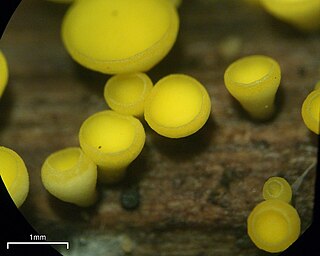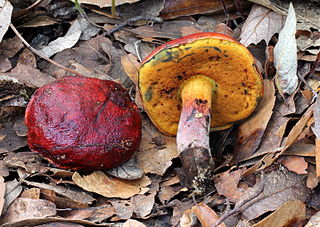
The arrondissement of Saint-Quentin is an arrondissement of France in the Aisne department in the Hauts-de-France region. It has 126 communes.

Bisporella citrina, commonly known as yellow fairy cups or lemon discos, is a species of fungus in the family Helotiaceae. The fungus produces tiny yellow cups up to 3 mm (0.12 in) in diameter, often without stalks, that fruit in groups or dense clusters on decaying deciduous wood that has lost its bark. The widely distributed species is found in North Africa, Asia, Europe, North America, and Central and South America. Found in late summer and autumn, the fungus is fairly common, but is easily overlooked owing to its small size. There are several similar species that can in most cases be distinguished by differences in color, morphology, or substrate. Microscopically, B. citrina can be distinguished from these lookalikes by its elliptical spores, which have a central partition, and an oil drop at each end.

Anthracobia is a genus of fungi in the family Pyronemataceae. The genus was circumscribed by Jean Louis Émile Boudier in 1885. Anthracobia is widely distributed in north temperate regions, and contains 15 species. Phylogenetic analyses suggest that the genus as currently circumscribed is polyphyletic.
Trichophaea is a genus of fungi in the family Pyronemataceae. The genus was circumscribed in 1885 by French pharmacist Jean Louis Émile Boudier in 1885.

Scutellinia scutellata, commonly known as the eyelash cup, the Molly eye-winker, the scarlet elf cap, the eyelash fungus or the eyelash pixie cup, is a small saprophytic fungus of the genus Scutellinia. It is the type species of Scutellinia, as well as being the most common and widespread. The fruiting bodies are small red cups with distinct long, dark hairs or "eyelashes". These eyelashes are the most distinctive feature and are easily visible with a magnifying glass. The species is common in North America and Europe, and has been recorded on every continent. S. scutellata is found on rotting wood and in other damp habitats, typically growing in small groups, sometimes forming clusters. It is sometimes described as inedible, but its small size means it is not suitable for culinary use. Despite this, it is popular among mushroom hunters due to its unusual "eyelash" hairs, making it memorable and easy to identify.

Verpa bohemica is a species of fungus in the family Morchellaceae. Commonly known as the early morel or the wrinkled thimble-cap, it is one of several species known informally as a "false morel". The mushroom has a pale yellow or brown thimble-shaped cap—2 to 4 cm in diameter by 2 to 5 cm long—that has a surface wrinkled and ribbed with brain-like convolutions. The cap hangs from the top of a lighter-colored, brittle stem that measures up to 12 cm (4.7 in) long by 1 to 2.5 cm thick. Microscopically, the mushroom is distinguished by its large spores, typically 60–80 by 15–18 µm, and the presence of only two spores per ascus.

Urnula is a genus of cup fungi in the family Sarcosomataceae, circumscribed by Elias Magnus Fries in 1849. The genus contains several species found in Asia, Europe, Greenland, and North America. Sarcosomataceae fungi produce dark-colored, shallow to deep funnel-shaped fruitbodies with or without a stipe, growing in spring. The type species of the genus is Urnula craterium, commonly known as the devil's urn or the gray urn. Urnula species can grow as saprobes or parasites having an anamorphic state. The anamorphic form of U. craterium causes Strumella canker, on oak trees.
Podophacidium is a genus of fungi in the Dermateaceae family that contains two species found in Europe and North America. The type species, originally called Podophacidium terrestre Niessl, is currently known as Podophacidium xanthomelum.

Torrendiella is a genus of fungi in the family Sclerotiniaceae. It was circumscribed by Jean Louis Émile Boudier and John Torrey in 1911, with T. ciliata as the type species. Several species once placed in this genus were transferred to Hymenotorrendiella in 2014.

Discinella is a genus of fungi in the family Helotiaceae. The genus, which contains an estimated 12 species, was circumscribed by Jean Louis Émile Boudier in 1885.

Pseudoplectania is a genus of fungi in the family Sarcosomataceae. The genus contains 12 species. Pseudoplectania ryvardenii was described in 2012, while Pseudoplectania carranzae was transferred to the genus in 2013.

Pachyella is a genus of fungi in the family Pezizaceae. It was circumscribed by Jean Louis Émile Boudier in 1907.

Wynnella is a genus of ascomycete fungi of the family Helvellaceae. It contains two species, the type, W. auricula, and W. silvicola. The genus was circumscribed by French mycologist Jean Louis Émile Boudier in 1885. Wynnella is a sister genus to Helvella.
Wynnella auricula is a species of fungus in the family Helvellaceae, and the type species of genus Wynnella. It was first described in 1763 by German mycologist Jacob Christian Schäffer as Peziza auricula. Jean Louis Émile Boudier transferred it to Wynnella in 1885.

Trichoglossum hirsutum is a species of fungi in the family Geoglossaceae. They are commonly called black earth tongues.

Rubroboletus dupainii, commonly known as Dupain's bolete, is a bolete fungus of the genus Rubroboletus. It is native to Europe, where it is threatened, and red listed in six countries. It also occurs in North America, although it is rare there. It was first recorded from North Carolina, and then from Iowa in 2009. It was reported from Belize in 2007, growing under Quercus peduncularis and other oaks.

Morchella eximia is a globally-occurring fungus in the family Morchellaceae (Ascomycota), first described by Émile Boudier in 1910. In an elaborate phylogenetic and nomenclatural revision of the genus in 2014, Richard and colleagues showed that the taxa Morchella anthracophila, Morchella carbonaria, and Morchella septimelata, proposed in 2012 by Clowez and Kuo et al. respectively, are all later synonyms of this old taxon.
Morchella dunalii is a species of fungus in the family Morchellaceae (Ascomycota). Although this widespread species was described as early as 1887 by Emile Boudier, it had not appeared in any of the influential literature or monographic works on the genus until very recently. The revival of the name is owed to Moreau and colleagues, who in 2011 designated a lectotype from an old watercolour painting of this forgotten taxon. Subsequent molecular phylogenetic studies by Richard and colleagues in 2014, matched this taxon to phylogenetic lineage Mel-25.
















